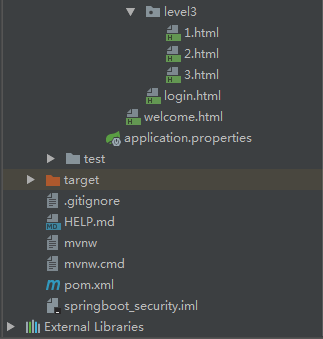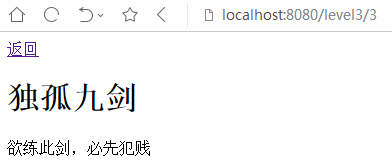1、新建一个springboot项目,选择web、thymeleaf、spring security
2、创建好当前文件和目录结构


3、首先是一些相关的界面
pom.xml
<?xml version="1.0" encoding="UTF-8"?> <project xmlns="http://maven.apache.org/POM/4.0.0" xmlns:xsi="http://www.w3.org/2001/XMLSchema-instance" xsi:schemaLocation="http://maven.apache.org/POM/4.0.0 https://maven.apache.org/xsd/maven-4.0.0.xsd"> <modelVersion>4.0.0</modelVersion> <parent> <groupId>org.springframework.boot</groupId> <artifactId>spring-boot-starter-parent</artifactId> <version>2.2.4.RELEASE</version> <relativePath/> <!-- lookup parent from repository --> </parent> <groupId>com.ging</groupId> <artifactId>springboot-security</artifactId> <version>0.0.1-SNAPSHOT</version> <name>springboot-security</name> <description>Demo project for Spring Boot</description> <properties> <java.version>1.8</java.version> </properties> <dependencies> <dependency> <groupId>org.springframework.boot</groupId> <artifactId>spring-boot-starter-security</artifactId> </dependency> <dependency> <groupId>org.springframework.boot</groupId> <artifactId>spring-boot-starter-thymeleaf</artifactId> </dependency> <dependency> <groupId>org.thymeleaf.extras</groupId> <artifactId>thymeleaf-extras-springsecurity5</artifactId> </dependency> <dependency> <groupId>org.springframework.boot</groupId> <artifactId>spring-boot-starter-web</artifactId> </dependency> <dependency> <groupId>org.springframework.boot</groupId> <artifactId>spring-boot-starter-test</artifactId> <scope>test</scope> <exclusions> <exclusion> <groupId>org.junit.vintage</groupId> <artifactId>junit-vintage-engine</artifactId> </exclusion> </exclusions> </dependency> <dependency> <groupId>org.springframework.security</groupId> <artifactId>spring-security-test</artifactId> <scope>test</scope> </dependency> </dependencies> <build> <plugins> <plugin> <groupId>org.springframework.boot</groupId> <artifactId>spring-boot-maven-plugin</artifactId> </plugin> </plugins> </build> </project>
welcome.html
<!DOCTYPE html> <html xmlns:th="http://www.thymeleaf.org" xmlns:sec="http://www.thymeleaf.org/thymeleaf-extras-springsecurity5"> <head> <meta http-equiv="Content-Type" content="text/html; charset=UTF-8"> <title>Insert title here</title> </head> <body> <h1 align="center">欢迎光临武林秘籍管理系统</h1> <div sec:authorize="!isAuthenticated()"> <h2 align="center">游客您好,如果想查看武林秘籍 <a th:href="@{/userlogin}">请登录</a></h2> </div> <div sec:authorize="isAuthenticated()"> <h2 align="center"> <span sec:authentication="name"></span>,您好,您的角色有: <span sec:authentication="principal.authorities"></span> <form th:action="@{/logout}" method="post"> <input type="submit" value="注销"/> </form> <h2> </div> <hr> <div sec:authorize="hasRole('VIP1')"> <h3>普通武功秘籍</h3> <ul> <li><a th:href="@{/level1/1}">罗汉拳</a></li> <li><a th:href="@{/level1/2}">武当长拳</a></li> <li><a th:href="@{/level1/3}">全真剑法</a></li> </ul> </div> <div sec:authorize="hasRole('VIP2')"> <h3>高级武功秘籍</h3> <ul> <li><a th:href="@{/level2/1}">太极拳</a></li> <li><a th:href="@{/level2/2}">七伤拳</a></li> <li><a th:href="@{/level2/3}">梯云纵</a></li> </ul> </div> <div sec:authorize="hasRole('VIP3')"> <h3>绝世武功秘籍</h3> <ul> <li><a th:href="@{/level3/1}">葵花宝典</a></li> <li><a th:href="@{/level3/2}">龟派气功</a></li> <li><a th:href="@{/level3/3}">独孤九剑</a></li> </ul> </div> </body> </html>
说明:重要的地方已经加粗放大了。
login.html
<!DOCTYPE html> <html xmlns:th="http://www.thymeleaf.org"> <head> <meta charset="UTF-8"> <title>Insert title here</title> </head> <body> <h1 align="center">欢迎登陆武林秘籍管理系统</h1> <hr> <div align="center"> <form th:action="@{/userlogin}" method="post"> 用户名:<input name="username"/><br> 密码:<input name="password"><br/> <input type="checkbox" name="remember">记住我<br/> <input type="submit" value="登陆"> </form> </div> </body> </html>
这里只展示其中一个1.html,它们大致相同:
<!DOCTYPE html> <html xmlns:th="http://www.thymeleaf.org"> <head> <meta http-equiv="Content-Type" content="text/html; charset=UTF-8"> <title>Insert title here</title> </head> <body> <a th:href="@{/}">返回</a> <h1>罗汉拳</h1> <p>罗汉拳站当央,打起来不要慌</p> </body> </html>
KungfuController.java
package com.ging.springbootsecurity.controller; import org.springframework.stereotype.Controller; import org.springframework.web.bind.annotation.GetMapping; import org.springframework.web.bind.annotation.PathVariable; @Controller public class KungfuController { private final String PREFIX = "pages/"; /** * 欢迎页 * @return */ @GetMapping("/") public String index() { return "welcome"; } /** * 登陆页 * @return */ @GetMapping("/userlogin") public String loginPage() { return PREFIX+"login"; } /** * level1页面映射 * @param path * @return */ @GetMapping("/level1/{path}") public String level1(@PathVariable("path")String path) { return PREFIX+"level1/"+path; } /** * level2页面映射 * @param path * @return */ @GetMapping("/level2/{path}") public String level2(@PathVariable("path")String path) { return PREFIX+"level2/"+path; } /** * level3页面映射 * @param path * @return */ @GetMapping("/level3/{path}") public String level3(@PathVariable("path")String path) { return PREFIX+"level3/"+path; } }
MySecurityConfig.java
package com.ging.springbootsecurity.config; import org.springframework.context.annotation.Configuration; import org.springframework.security.config.annotation.authentication.builders.AuthenticationManagerBuilder; import org.springframework.security.config.annotation.web.builders.HttpSecurity; import org.springframework.security.config.annotation.web.configuration.EnableWebSecurity; import org.springframework.security.config.annotation.web.configuration.WebSecurityConfigurerAdapter; import org.springframework.security.crypto.bcrypt.BCryptPasswordEncoder; @Configuration @EnableWebSecurity public class MySecurityConfig extends WebSecurityConfigurerAdapter { //控制请求访问权限 @Override protected void configure(HttpSecurity http) throws Exception { //定制请求授权规则 http.authorizeRequests() .antMatchers("/").permitAll() .antMatchers("/level1/**").hasRole("VIP1") .antMatchers("/level2/**").hasRole("VIP2") .antMatchers("/level3/**").hasRole("VIP3"); //开启自动配置的登录功能 //1、login请求来到登录页面 //2、重定向/login?Error表示登录失败 //3、设置转到我们自己的登录界面 //4、自定义的登录界面要发送post请求,action需要为/login,字段要匹配这里的 http.formLogin().usernameParameter("username").passwordParameter("password").loginPage("/userlogin");//.loginProcessingUrl("/login") //开启自动配置的注销功能 //1、访问logout表示用户注销,清空session //2、默认注销成功会返回login?logout页面 //3、设置注销成功来到首页 http.logout().logoutSuccessUrl("/"); //开启记住我功能 http.rememberMe().rememberMeParameter("remember"); } //定义认证规则 @Override protected void configure(AuthenticationManagerBuilder auth) throws Exception { auth.inMemoryAuthentication().passwordEncoder(new BCryptPasswordEncoder()) .withUser("zhangsan").password(new BCryptPasswordEncoder().encode("123456")) .roles("VIP1","VIP2") .and() .withUser("lisi").password(new BCryptPasswordEncoder().encode("123456")) .roles("VIP2","VIP3"); } }
接下来跟着实际的操作一步步探索。
启动服务器:

首先输入localhost:8080,会自动跳转到welcome.html,由于我们配置了authorizeRequests()和formLogin(),并且设置了/level?/**的权限,所以我们在浏览器输入localhost:8080/level/1等请求时,由于没有登录,即不是哪一个用户,所以会跳转到springboot自定义的login界面。

如果我们不定义自己的登录页面的话,系统确实会跳转到springboot自己的界面,但是我们若想要跳转到自己的界面呢?
http.formLogin().usernameParameter("username").passwordParameter("password").loginPage("/userlogin");//.loginProcessingUrl("/login")
这里需要设置用户名和密码的名称,以及自动跳转的页面,即发送/userlogin请求,而/userlogin请求则会返回我们真正的登录界面:login.html。在login.html中输入框里面的name要和这里的分别对应,同时我们还要发送post请求,对应的action要与发送的请求相同,即为@{/userlogin}。我们设置记住我时,同样要置http.rememberMe().rememberMeParameter("remember");对应的名称。然后我们输入:
@Override protected void configure(AuthenticationManagerBuilder auth) throws Exception { auth.inMemoryAuthentication().passwordEncoder(new BCryptPasswordEncoder()) .withUser("zhangsan").password(new BCryptPasswordEncoder().encode("123456")) .roles("VIP1","VIP2") .and() .withUser("lisi").password(new BCryptPasswordEncoder().encode("123456")) .roles("VIP2","VIP3"); }
这里定义好的角色,一般这里是从数据库中获取,这里就只进行模拟。比如输入:zhangsan,密码:123456,我们就会进入到:

在welcome.html界面可以通过sec属性来获取相关的值。通过isAuthenticated来判断当前的用户是否具有权限,有的化我们的欢迎界面就变化了,显名称以及角色。然后在不同的代码块中我们有<div sec:authorize="hasRole('VIP1')">标识。zhangsan拥有“VIP1”和“VIP2”角色,因此可以看到普通武功秘籍和高级武功秘籍。我们点击注销,就可以退出登录。在配置文件中定义了注销后返回到主界面。由于此时没有了权限,则会显示欢迎您,游客。。。
接下来我们再试一下登录:lisi 123456,并勾选记住我。

点进去看一本:

它是VIP2和VIP3,因此可以看到高级武功秘籍和绝世武功秘籍。由于我们勾选了记住我,所以我们关闭这个界面,在访问localhost:8080,此时就不需要我们再进行登陆了。
总结:基本上实现了普通游客只有在登录了之后才能够访问到level?/**下的内容,强行访问会被拦截到登录界面。用户登陆之后根据不同角色显示不同内容。勾选记住我后会保存一个cookie,再次访问不需要再登录,点击注销之后删除cookie,退出登录。